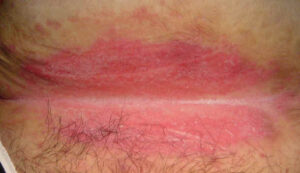 Intertrigo is one of the most common skin conditions that I see both in my Conroe dermatology and Woodlands dermatology offices. It is sometimes called a “heat rash” and occurs anywhere two skin surfaces rub together which produces friction and heat. This friction causes skin breakdown, which initially becomes red and inflamed and can ultimately develop fissures and erosions. Initially, intertrigo is not infected but is merely a rash. However, it provides a perfect environment for Candida to grow and become pathogenic.
Intertrigo is one of the most common skin conditions that I see both in my Conroe dermatology and Woodlands dermatology offices. It is sometimes called a “heat rash” and occurs anywhere two skin surfaces rub together which produces friction and heat. This friction causes skin breakdown, which initially becomes red and inflamed and can ultimately develop fissures and erosions. Initially, intertrigo is not infected but is merely a rash. However, it provides a perfect environment for Candida to grow and become pathogenic.
What Areas Does Intertrigo Affect?
The groin is the most commonly affected area but it can occur around the neck, in the axillae, the inframammary area, under skin folds, and between the fingers and toes. If yeast or fungus is present, treatment is first directed against the infecting microorganism, then anti-inflammatory creams are used.
What Treatment Options Are Available?
I prefer desonide cream twice a day until the intertrigo has resolved. Desonide is a prescription steroid cream that is Class 6 (Class 7 is the least potent) and is safe to use in the intertriginous areas. It is important to use a low potency steroid in these areas as the anatomy of two skin surfaces in contact creates a condition called occlusion that increases the strength of topical steroids. Thus, a Class 6 steroid under occlusion may develop the potency of a Class 4 or 5 steroid. Once the inflammation has cleared, the steroid is discontinued and used only if the intertrigo recurs. Powders such as Johnson and Johnson Baby Powder or Gold Bond Powder are excellent for keeping intertriginous areas dry, and they reduce the friction in these areas as they function like little ball bearings that allow the skin to essentially slide smoothly across each other.
Learn more about the rash treatment options available from Dr. Perri in The Woodlands and Conroe.




